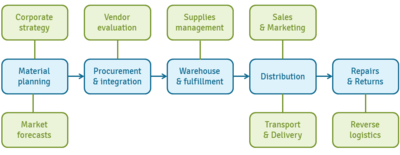Supply logistics subsystem: Difference between revisions
mNo edit summary |
(The LinkTitles extension automatically added links to existing pages (<a target="_blank" rel="noreferrer noopener" class="external free" href="https://github.com/bovender/LinkTitles">https://github.com/bovender/LinkTitles</a>).) |
||
| Line 14: | Line 14: | ||
}} | }} | ||
The tasks carried out within the framework of '''supply [[logistics]] subsystem''' rely primarily on providing the required raw materials (including support and maintenance), intermediates, spare parts, products and other resources with accompanying [[information]]. Goods are delivered to the warehouse of the recipient or directly to the places of their use. | The tasks carried out within the framework of '''supply [[logistics]] [[subsystem]]''' rely primarily on providing the required raw materials (including support and maintenance), intermediates, spare parts, products and other resources with accompanying [[information]]. Goods are delivered to the warehouse of the recipient or directly to the places of their use. | ||
Main task of the supply logistics is to ensure that appropriate goods necessary in the [[manufacturing process]] and in maintaining the availability of long-term [[production]] are provided. And they meet the requirements of the recipient. Such tasks are specific to the activities of marketing and originally [[marketing]] methods was used in the supply area. | Main task of the supply logistics is to ensure that appropriate goods necessary in the [[manufacturing process]] and in maintaining the availability of long-term [[production]] are provided. And they meet the requirements of the recipient. Such tasks are specific to the activities of marketing and originally [[marketing]] methods was used in the supply area. | ||
Revision as of 02:48, 21 January 2023
| Supply logistics subsystem |
|---|
| See also |
The tasks carried out within the framework of supply logistics subsystem rely primarily on providing the required raw materials (including support and maintenance), intermediates, spare parts, products and other resources with accompanying information. Goods are delivered to the warehouse of the recipient or directly to the places of their use.
Main task of the supply logistics is to ensure that appropriate goods necessary in the manufacturing process and in maintaining the availability of long-term production are provided. And they meet the requirements of the recipient. Such tasks are specific to the activities of marketing and originally marketing methods was used in the supply area.
The decisions in terms of supply can not be taken without taking into account conditions on the market that are shaped primarily by the following factors:
- Characteristics of the purchased goods - mainly concerning requirements in the fields of transport (means of transport, its accessories), storage (surface area, location, conditions of storage), packaging (size, material) and labelling
- Providers activity - including especially the quantity, degree of compliance with the requirements, opportunity to ensure a long term cooperation, focus on closer cooperation with the customer and mutual improving actions,
- Activities of competitors - primarily the amount, location, scope of impact, sources of supply, potential, logistic solutions used in the area of procurement,
- Restrictions in trading - related to licensing, the need for monitoring by external bodies (i.e. drugs, substances harmful to health)
- International movement of goods - especially because of the differences in the requirements for the transport and storage of goods, the lack of standardization of the documentation of carriage and storage, delays resulting from low bandwidth border crossings.
See also:
References
- Farahani, R. Z., Asgari, N., & Davarzani, H. (Eds.). (2009). Supply chain and logistics in national, international and governmental environment: concepts and models. Springer Science & Business Media.
